Dear Patrons of Countercurrents.org,
Giving Tuesday is still not over. Give whatever you can for peace, justice, harmony and the future of our planet and our children.
Give whatever you can. It's crucial for the survival of Countercurrents.
In Solidarity
Binu Mathew
Editor
Countercurrents.org
Dear Friend,
Exceptional global heat driven by greenhouse gas (GHG) emissions mean this decade will most likely go down as the warmest on record, according to the World Meteorological Organization (WMO), which released its provisional statement on the State of the Global Climate on Tuesday.
John Scales Avery has published a freely downloadable online book that addresses the many challenges affecting our children's future
Kindly support honest journalism to survive. https://countercurrents.org/subscription/
If you think the contents of this news letter are critical for the dignified living and survival of humanity and other species on earth, please forward it to your friends and spread the word. It's time for humanity to come together as one family! You can subscribe to our news letter here http://www.countercurrents.org/news-letter/.
In Solidarity
Binu Mathew
Editor
Countercurrents.org
Decade ending 2019 likely to be the hottest on record, says WMO
by Countercurrents
Collective
Exceptional global heat driven by greenhouse gas (GHG) emissions mean this decade will most likely go down as the warmest on record, according to the World Meteorological Organization (WMO), which released its provisional statement on the State of the Global Climate on Tuesday.
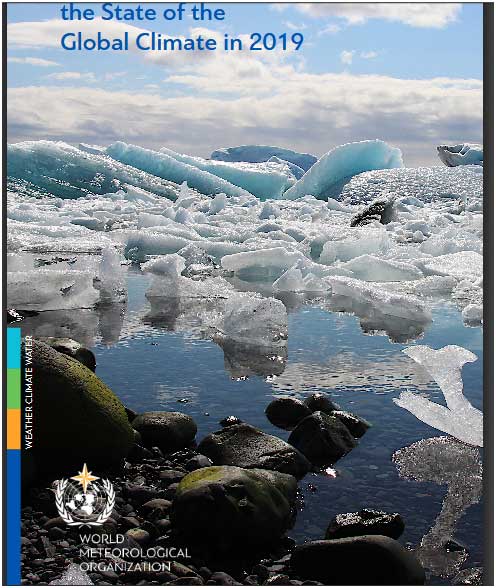
Exceptional global heat driven by greenhouse gas (GHG) emissions mean this decade will most likely go down as the warmest on record, according to the World Meteorological Organization (WMO), which released its provisional statement on the State of the Global Climate on Tuesday.

The WMO also finds that 2019 is on track to be the second or third warmest year in history, with the global average temperature during January through October, roughly 1.1 degrees Celsius above the pre-industrial era.

“If we do not take urgent climate action now, then we are heading for a temperature increase of more than 3°C by the end of the century, with ever more harmful impacts on human wellbeing”, said WMO Secretary-General Petteri Taalas.
“We are nowhere near on track to meet the Paris Agreement target,” he added, referring to the 2015 international accord to limit global warming to 1.5°C above pre-industrial levels.
The closing decade has been the warmest on record, with negative impacts on human health, data collected by the WMO and the World Health Organization (WHO) shows.
The new reports were presented on December 3, 2019 at the 25th United Nations Climate Change Conference (COP25) in Madrid.
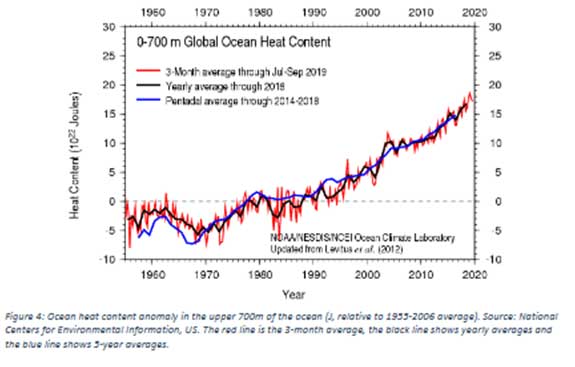
According to WMO, global average temperatures for the five-year (2015-2019) and 10-year (2010-2019) periods will be the highest ever recorded. With temperature above the pre-industrial period around 1.1°C between January and October 2019 is set to be the second or third warmest year on record.
Concentrations of GHG in the atmosphere, which hit a record level of 407.8 parts of CO2 per million in 2018, continued to rise this year. Ocean heat is also at record levels and seawater is 26% more acidic than at the start of the industrial era, as daily sea-ice extent in the Arctic and Antarctica saw record lows in recent months.
CO2 and sea levels on the rise
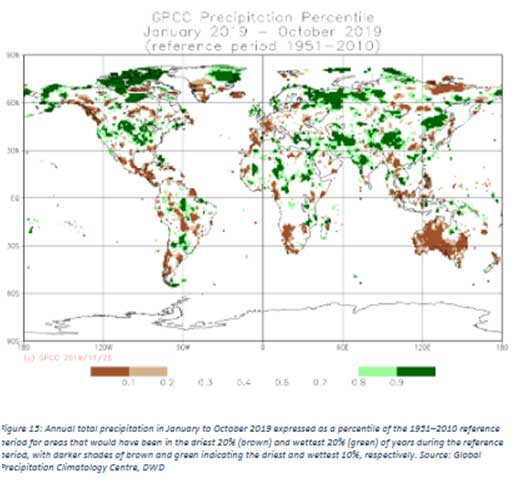
The report finds that concentrations of carbon dioxide (CO2) in the atmosphere, which hit record levels last year, also continued to rise in 2019.
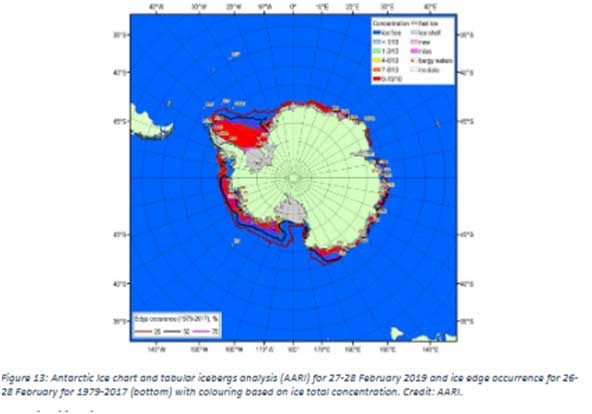
The WMO said: Sea level rise has increased due to melting of the ice sheets in Greenland and Antarctica, while ocean heat is at record levels, with vital marine ecosystems being degraded.
Several UN agencies provided input to the report, which also details how weather and climate have an impact on health, food security, migration, ecosystems and marine life.
Climate variability and extreme weather events are among key drivers of the recent rise in global hunger, which now affects more than 820 million people.
“On a day-to-day basis, the impacts of climate change play out through extreme and “abnormal” weather. And, once again in 2019, weather and climate related risks hit hard”, said Taalas.
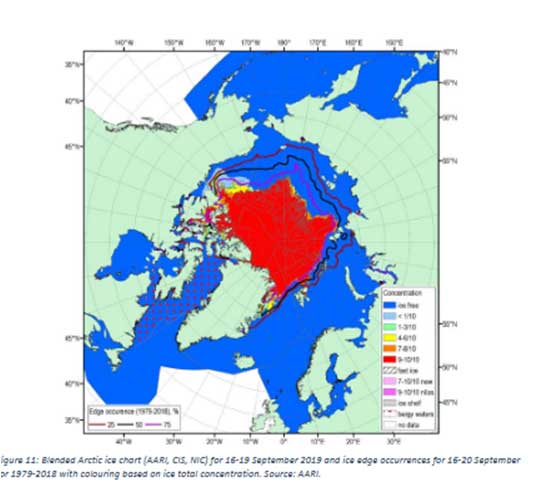
“Heatwaves and floods which used to be “once in a century” events are becoming more regular occurrences. Countries ranging from the Bahamas to Japan to Mozambique, suffered the effect of devastating tropical cyclones. Wildfires swept through the Arctic and Australia.”
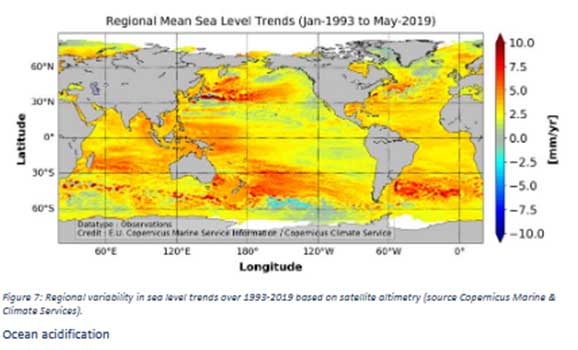
Health at risk
Record-setting temperatures are increasingly putting health at risk, according to input provided by the WHO. Major heatwaves in Japan in late July to early August caused more than 100 deaths and some 18,000 hospitalizations, for example.
About half the global population is now threatened by dengue as changes in climatic conditions are making it easier for the Aedes mosquito species to transmit the dengue virus.
Southern Africa has experienced extensive dry periods due to a delay in the start of the seasonal rains, the Food and Agriculture Organization (FAO) reports. As cereal output is forecasted to be around eight per cent below the five-year average, some 12.5 million people in the region will face food insecurity.
Climate-related disasters are also increasing displacement. Figures from the UN refugee agency, UNHCR, reveal more than 10 million new internal displacements were recorded during the first half of the year, with seven million forced to move as a result of disasters such as cyclones and flooding. New displacements associated with weather extremes could more than triple, to around 22 million by the end of the year.
The provisional report was released as governments meet in Madrid COP25.
WMO will publish the final Statement on the State of the Climate, with complete 2019 data, in March.
Key messages from the report
Global atmospheric concentrations of GHG reached record levels in 2018 with carbon dioxide (CO2) reaching 407.8±0.1 parts per million, 147% of pre-industrial levels.
Measurements from individual sites indicate that concentrations of CO2 continued to increase in 2019.
Methane and nitrous oxide, both important greenhouse gases, also reached record levels in 2018.
Global mean temperature for January to October 2019 was 1.1±0.1°C above pre-industrial levels. 2019 is likely to be the 2nd or 3rd warmest year on record.
The past five years are now almost certain to be the five warmest years on record, and the past decade, 2010-2019, to be the warmest decade on record. Since the 1980s, each successive decade has been warmer than any preceding decade since 1850.
The ocean absorbs over 90% of the heat trapped in the Earth system by rising concentrations of greenhouse gases. Ocean heat content, which is a measure of this heat accumulation, reached record levels again in 2019.
As the ocean warms, sea levels rise. This rise is further increased by melting of ice on land, which then flows into the sea. Short-term trends in sea level are modulated by transitions between La Niña and El Niño, a cooling and warming, respectively of the central and eastern Pacific Ocean surface temperature.
Sea level has increased throughout the altimeter record, but recently sea level rose at a higher rate due partly to melting of ice sheets on Greenland and Antarctica. In autumn 2019, the global mean sea level reached its highest value since the beginning of the high-precision altimetry record (January 1993).
Over the decade 2009-2018, the ocean absorbed around 22% of the annual emissions of CO2, attenuating atmospheric concentrations. However, CO2 reacts with seawater and decreases its pH, a process called ocean acidification. Observations from open-ocean sources over the last 20 to 30 years show a clear decrease in average pH at a rate of 0.017–0.027 pH units per decade since the late 1980s.
2019 saw low sea-ice extent both in the Arctic and Antarctic. The daily Arctic ice extent minimum in September 2019 was the second lowest in the satellite record and October has seen further record low extents.
In Antarctica, variability in recent years has been high with the long-term increase offset by a large drop in extent in late 2016. 2019 saw record low extents in some months.
Tropical cyclone Idai was one of the strongest known cyclones to make landfall on the east coast of Africa. There was widespread destruction from wind damage and storm surge in coastal Mozambique, especially in the city of Beira, whilst severe flooding extended to inland regions of Mozambique and parts of Zimbabwe. Tropical Cyclone Idai played a role to the destruction of close to 780 000 ha of crops in Malawi, Mozambique, and Zimbabwe, further undermining a precarious food security situation in the region. The cyclone also resulted in at least 50 905 displaced persons in Zimbabwe, 53 237 in southern Malawi and 77 019 in Mozambique.
Extreme heat conditions are taking an increasing toll on human health and health systems. Greater impacts are recorded in locations where extreme heat occurs in contexts of aging populations, urbanization, urban heat island effects, and health inequities.
In 2018, a record 220 million vulnerable persons over age of 65 were exposed to heatwaves, compared with the average for the baseline of 1986-2005.
In addition to conflicts, insecurity and economic slowdowns and downturns, climate variability and extreme weather events are among the key drivers of the recent rise in global hunger and one of the leading causes of severe food crises. After a decade of steady decline, hunger is on the rise again –over 820 million people suffered from hunger in 2018. The situation is most severe in sub-Saharan Africa, where the number of undernourished people increased by more than 23 million between 2015 and 2018, particularly in countries affected by conflict.
Among 33 countries affected by food crises in 2018, climate variability and weather extremes were a compounding driver together with economic shocks and conflict in 26 countries and the leading driver in 12 of the 26.
More than 10 million new internal displacements were recorded between January and June 2019. Of these, 7 million were triggered by hydrometeorological events including Cyclone Idai in southeast Africa, Cyclone Fani in south Asia, Hurricane Dorian in the Caribbean, and flooding in Iran, the Philippines and Ethiopia, generating acute humanitarian and protection needs.
Among natural hazards, floods and storms have contributed the most to displacement recorded so far in 2019, followed by droughts. Asia and the Pacific remain the regions most prone to disaster displacement due to both sudden and slow-onset disasters. For instance, more than 2 million people were evacuated in Bangladesh, the second most disaster-prone country in the region, due to Cyclone Bulbul in November, and more than 2 million in China due to Typhoon Lekima in August.
The global mean temperature for the period January to October 2019 was around 1.1 ± 0.1 °C above pre-industrial levels (1850-1900). 2019 is likely to be the second or third warmest year on record. The WMO assessment is based on five global temperature data sets, with four of the five global temperature data sets putting 2019 in second place. The spread of the five estimates is between 1.04 °C and 1.17 °C.
The IPCC Special Report on 1.5°C (IPCC SR15) concluded that “Human-induced warming reached approximately 1°C (likely between 0.8°C and 1.2°C) above pre-industrial levels in 2017, increasing at 0.2°C (likely between 0.1°C and 0.3°C) per decade (high confidence)”. An update of the figures to 2019 is consistent with continued warming in the range 0.1-0.3°C/decade.2016, which began with an exceptionally strong El Niño, remains the warmest year on record. Weak El Niño conditions in the first half of 2019 may have made a small contribution to the high global temperatures in 2019, but there was no clear increase in temperature at the end of 2018/early 2019 as was seen in late 2015/early 2016.Based on the year-to-date figures, the past five years, 2015 to 2019, are almost certain to be the five warmest years on record. The five-year (2015-2019) and ten-year (2010-2019) averages are, respectively, almost certain to be the warmest five-year period and decade on record5. Since the 1980s, each successive decade has been warmer than any preceding decade since 1850.
Our Children’s Future
by John Scales Avery
John Scales Avery has published a freely downloadable online book that addresses the many challenges affecting our children's future
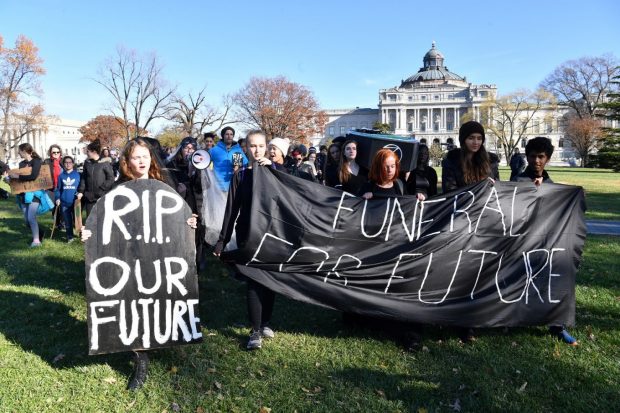
Loving care for our children
We give our children loving care, but it makes no sense to do so unless we do everything in our power to give them a future world in which they can survive. We also have a duty to our grandchildren, and to all future generations.
Today we are faced with the threat of an environmental megacatastrophe, of which the danger of catastrophic climate change is a part. We also face the threat of an all-destroying nuclear war.
Finally, because of population growth, the effect of climate change on agriculture, and the end of the fossil fuel era, there is a danger that by the middle of the present century a very large-scale famine could take the lives of as many as a billion people.
We owe it to our children to take urgent action to prevent these threats from becoming future realities. We must also act with dedication to save our children from other social ills that currently prevent their lives from developing in a happy and optimal way, for example child labor, child slavery, starvation, preventable disease and lack of education. These, too, are threats to our children’s future.
The climate emergency: Urgent action is needed
The annual Emissions Gap report from the U.N. Environmental Program (UNEP), released on November 26, 2019, warned that nations’ commitments under the Paris climate accord – from which U.S. President Donald Trump began formally withdrawing this month – are not nearly sufficient to bring about the widespread changes needed to avert climate catastrophe.
The report stated that global temperatures are on track to rise as much as 3.2$^o$C by the end of the century, meaning only drastic and unprecedented emissions reductions can stave off the most devastating consequences of the climate crisis. What is needed, according to the report, is a complete halt in the production of fossil fuels.
Renewable energy is now cheaper than fossil fuels, so the transition to renewables could be driven by economic forces alone, if governments worldwide would stop their sponsorship of fossil fuel industries, to which they currently give enormous tax benefits and other subsidies.
Other urgently needed actions are a halt to deforestation, combined with massive reforestation, substitution of other building materials for cement, better climate coverage in the mass media, abandonment of growth-oriented economic goals, shift to more plant-based diet, and deep cuts in military activities.
We must rid the world of nuclear weapons
A Treaty banning nuclear weapons was adopted by an overwhelming majority vote on the floor of the UN General Assembly, following the precedent set by the Arms Trade Treaty. The Treaty on the Prohibition of Nuclear Weapons was passed on 7 July, 2017. It prohibits the development, testing, production, stockpiling, stationing, transfer, use and threat of use of nuclear weapons, as well as assistance and encouragement to the prohibited activities. For nuclear armed states joining the treaty, it provides for a time-bound framework for negotiations leading to the verified and irreversible elimination of its nuclear weapons programme.
The International Campaign to Abolish Nuclear Weapons (ICAN) campaigned vigorously for the adoption of the Treaty, and was awarded the 2017 Nobel Peace Prize for its efforts. Although bitterly opposed by nuclear weapons states, the Treaty has great normative value, and one fervently hopes that the force of public opinion will eventually force all governments to give their citizens what the vast majority long for: a nuclear-weapon-free world.
It is generally agreed that a full-scale nuclear war would have disastrous effects, not only on belligerent nations but also on neutral countries. As long as there are nations that possess nuclear weapons, there is a danger that they will be used, either deliberately or through a technical or human error, or through unconcontrollable escalation of a conflict. Only a nuclear-free world will be safe for our children and the biosphere.
We must address the threat of widespread famine
As glaciers melt in the Himalayas, depriving India and China of summer water supplies; as sea levels rise, drowning the fertile rice fields of Viet Nam and Bangladesh; as drought threatens the productivity of grain-producing regions of North America; and as the end of the fossil fuel era impacts modern high-yield agriculture, there is a threat of wide-spread famine. There is a danger that the 1.5 billion people who are undernourished today will not survive an even more food-scarce future.
People threatened with famine will become refugees, desperately seeking entry into countries where food shortages are less acute. Wars, such as those currently waged in the Middle East, will add to the problem.
What can we do to avoid this crisis, or at least to reduce its severity? We must urgently address the problem of climate change; and we must shift money from military expenditure to the support of birth control programs and agricultural research. We must also replace the institution of war by a system of effective global governance and enforcible international laws.
We must eliminate child labor and child slavery
Worldwide 10 million children are in slavery, trafficking, debt bondage and other forms of forced labor, forced recruitment for armed conflict, prostitution, pornography and other illicit activities, according to the International Labor Organization, (ILO). 151.6 million are estimated to be in child labor (ILO). 114 million child laborers are below the age of 14 (ILO). 72 million children are in hazardous work that directly endangers their health, safety and moral development (ILO). More than 700 million women alive today were married before their 18th birthday. More than one in three (about 250 million) entered into union before age 15 (UNICEF). 300,000 children are estimated to serve as child soldiers, some even younger than 10 years old (UNICEF). 15.5 million children are in domestic work worldwide – the overwhelming majority of them are girls (ILO).
Child labor is undesirable because it prevents children from receiving an education. Furthermore, when parents regard their children as a source of labor or income, it motivates the to have very large families, and our finite earth, unlimited growth of population is a logical impossibility. Population growth increases the threat of large-scale famine as well as ecological catastrophe.
Child slavery is unacceptable, as is any form of slavery. Forced marriage, and very early marriage of girls as young as 9 in some countries are also unacceptable practices. The international community has a duty to see that existing laws against these practices are enforced.
We must reduce starvation and preventable disease
According to a recent report published by the World Health Organization, in 2018 alone, 15,000 children died per day before reaching their fifth birthday. A WHO spokesman said, “It is especially unacceptable that these children and young adolescents died largely of preventable or treatable causes like infectious diseases and injuries when we have the means to prevent these deaths,” the authors write in the introduction to the report. The global under-five mortality rate fell to 39 deaths per 1,000 live births in 2018, down from 76 in 2000 – a 49% decline.
“Despite advances in fighting childhood illnesses, infectious diseases remain a leading cause of death for children under the age of 5, particularly in sub-Saharan Africa and Southern Asia,” says the report. Pneumonia remains the leading cause of death globally among children under the age of 5, accounting for 15% of deaths. Diarrhoea (8%) and malaria (5%), together with pneumonia, accounted for almost a third of global under-five deaths in 2018. “Malnourished children, particularly those with severe acute malnutrition, have a higher risk of death from these common childhood illnesses. Nutrition-related factors contribute to about 45 per cent of deaths in children under 5 years of age,” warns the report. The estimates also show vast inequalities worldwide, with women and children in sub-Saharan Africa facing a higher risk of death than in all other regions. Level of maternal deaths are nearly 50 times higher for women in sub-Saharan Africa compared to high-income countries. In 2018, 1 in 13 children in sub-Saharan Africa died before their fifth birthday – this is 15 times higher than the risk a child faces in Europe, where just 1 in 196 children aged less than 5 die.
We must provide universal reformed education
Illiteracy in the less developed countries exceeded that of the developed ones by a factor of ten in 1970. By 2000, this factor had increased to approximately 20. As our economies become more knowledge-based, education has become more and more important.
Besides universal education, educational reforms are urgently needed, particularly in the teaching of history. As it is taught today, history is a chronicle of power struggles and war, told from a biased national standpoint. Our own race or religion is superior; our own country is always heroic and in the right.
We urgently need to replace this indoctrination in chauvinism by a reformed view of history, where the slow development of human culture is described, giving adequate credit to all who have contributed.
The teaching of other topics, such as economics, should be reformed. Economics must be given both a social conscience and an ecological conscience. The mantra of growth must be abandoned, and the climate emergency must be addressed.
Childhood should be a time of joy
Children’s play is not a waste of time. Children at play are learning skills that they will use later in their lives. Let us allow our children to play and learn, while we work to give them a secure future world. Let us give our children, not predominantly material goods, but rather the love, happiness and future that they deserve.
A new freely downloadable book
I would like to announce the publication of a book, which examines the steps that we must take to give our children and their children a world in which thet can survive. The book may be freely downloaded and circulated from the following link:
Other books and articles about global problems are on these links
I hope that you will circulate the links in this article to friends and contacts who might be interested.
John Scales Avery is a theoretical chemist at the University of Copenhagen. He is noted for his books and research publications in quantum chemistry, thermodynamics, evolution, and history of science. His 2003 book Information Theory and Evolution set forth the view that the phenomenon of life, including its origin, evolution, as well as human cultural evolution, has its background situated in the fields of thermodynamics, statistical mechanics, and information theory. Since 1990 he has been the Chairman of the Danish National Group of Pugwash Conferences on Science and World Affairs. Between 2004 and 2015 he also served as Chairman of the Danish Peace Academy. He founded the Journal of Bioenergetics and Biomembranes, and was for many years its Managing Editor. He also served as Technical Advisor to the World Health Organization, Regional Office for Europe (19881997).
http://www.fredsakademiet.dk/ordbog/aord/a220.htm. He can be reached at avery.john.s@gmail.com. To know more about his works visit this link.
http://eacpe.org/about-john-scales-avery/
http://www.fredsakademiet.dk/ordbog/aord/a220.htm. He can be reached at avery.john.s@gmail.com. To know more about his works visit this link.
http://eacpe.org/about-john-scales-avery/
Going to the ICJ: Myanmar, Genocide and Aung San Suu Kyi’s Gamble
by Dr Binoy Kampmark
Myanmar’s Aung San Suu Kyi, with an ever dwindling number of peace prizes and awards to her name for questionable responses to the plight of the Rohingya Muslim
minority, has a plan. She intends to personally plead the case of her country against charges of genocide being made in the International Court of Justice. As the Ministry of the Interior has claimed, the argument against state brutality against the Rohingya has arisen due to ignorance about “the complexities of the issue and the narratives of the people of Myanmar.”
Moral Injury and America’s Endless Conflicts
by Arnold R Isaacs
I was a civilian journalist, not a soldier. I went to Vietnam to report, not to fight. I didn’t come home with any trauma symptoms. But I have all the feelings that Chaplain Orris listed as identifying markers for moral injury: sorrow, grief, regret, shame, and alienation. Those emotions come from what I learned about war, not from anything I did, and that makes me believe it may not be wrong to think that what we call moral injury might not be just one person’s
response to particularly troubling events, but a symptom of something larger, of seeing war individually and collectively for what it truly is.
Israel’s Aussie Mensch
by Dr Vacy Vlazna
The Zionist Federation of Australia bestowed in November its 2019 Jerusalem Prize for “exceptional in strengthening Australia-Israel relations” or as Prof. Stuart Rees puts it, ‘for sucking up to Israelis,’ on an exemplary recipient, the prime minister of Australia, Scott Morrison. Former meritorious recipients from the zionist mishpocheh are John Howard, Bob Hawke, Julia Gillard, Alex Downer and serial war crimes apologist (East Timor, Afghanistan, Iraq and Palestine etc.) Greg Sheridan.
A microcosm of Iran’s domestic problems, port city bears brunt of crackdown
by Dr James M Dorsey
The Iranian port city of
Bandar-e-Mahshahr has emerged as the scene of some of the worst violence in Iran’s brutal crackdown on recent anti-government protests.
A note on Capital Punishment
by Muhammed Jahfer
Deterring the future crimes and reforming the offenders have been the core objectives of the punishment. However, death penalty has, historically and factually, failed to achieve the deterrent effect. Reformation of the offenders cannot be achieved through death penalty as it does not even give a space to reform
Rahul Gandhi: The One Who India Betrayed
by Kabir Deb
Rahul Gandhi could have been a good leader, for a nation of young blood (most young nation needs a young leader like Rahul). Without giving him the chance to display his skills, trolling him displays the weak temperament we have for politics and its leaders. When the West chooses its
leaders, it only keeps in mind the age of the nation (it did a mistake by choosing Trump). If Canada would have gone over appearance, then Justin Trudeau would have been a Hollywood star and not the most influential president!
No comments:
Post a Comment